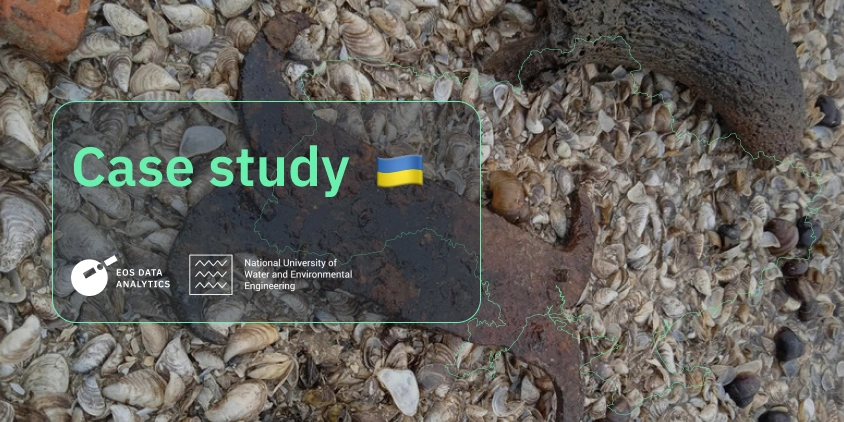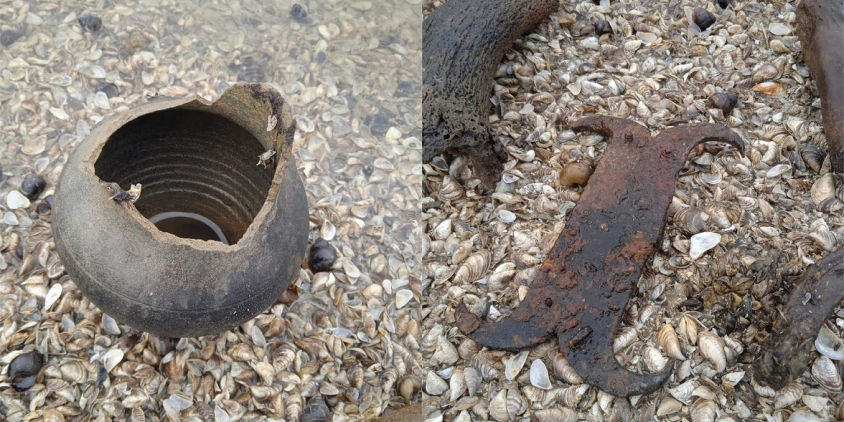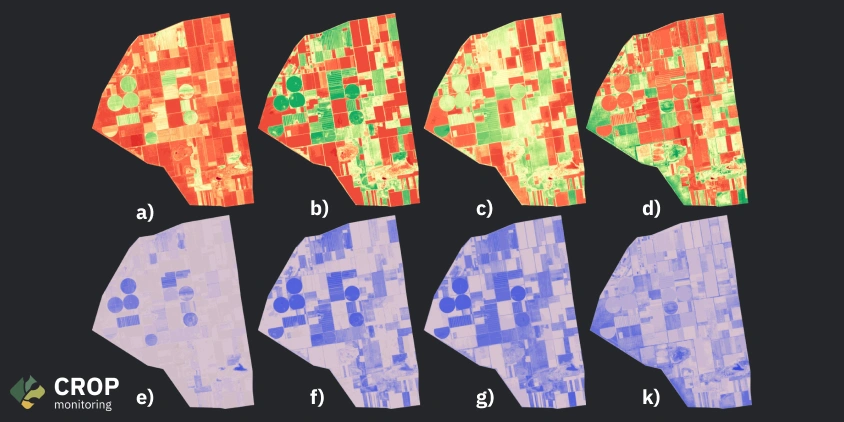
Serhii Klimov Found Soil Water Stress Via EOSDA’s Tools
The Kakhovka Dam’s destruction in June 2023 became an ecological disaster of a great scale. The massive reservoir of water flooded the surrounding areas, bringing death and destruction to them. Some people were able to evacuate, while their homes became unsuitable for living. The plants and all living beings there most likely drowned. The event called ‘ecocide’ impacted the whole region.
Some effects, however, were not so immediate. Kherson Oblast is known for its warm and dry climate. Thus, fields there relied heavily on the Dam that provided them with irrigation. Serhii Klimov, a scientist from the National University of Water and Environmental Engineering, Ukraine, decided to check on those fields that were dependent on artificial irrigation and determine how much fertility they carried before the Dam’s destruction. He and his colleague used EOSDA Crop Monitoring to see the water stress levels in the fields. Read on to see what he found.
| Problem | Kakhovka Dam’s destruction in 2023 caused water stress in the region, as the reservoir was a source of irrigation for southern fields. |
| Research | Serhii Klomov and his colleague used EOSDA Crop Monitoring to study plants’ water supply in a group of fields through temperature, precipitation, and NDMI and NDVI data. |
| Conclusion | Dam destruction can lead to serious agricultural degradation in the region as climatic factors do not allow plants to maintain the level of humidity necessary for plants naturally. |
Local Context: Kakhovka Dam Destruction
On June 6th, 2023, 18 cubic km of water flooded the region near Kakhovka Dam. Before that, in February 2022, Russia started a full-scale invasion of Ukraine, including occupying the Dam. The destruction of such a strategically and locally important structure impacted the entire region, and emotional effects shook the world. People from nearby villages fled or were evacuated, while local fauna had to fight their own way out. Local flora, of course, ended up being underwater, along with many historical and cultural sites.
The Dam, built in the 1950s, had its set of issues. When the reservoir was built, the excessive water flooded many territories, forcing the citizens to evacuate. Just like in 2023, locals had to pack their belongings and, in the blink of an eye, leave their homes, their history, and their culture. However, for the last 67 years, as a new landscape emerged, so did new settlements, culture, and history. It was all washed away by the massive flood. When the water receded, many old sites appeared, including graveyards and ancient artifacts. The bottom of the Kakhovka Dam revealed a variety of historical objects that once depicted everyday human life.

Aside from that, the historic Great Meadow (Velykyi Luh) appeared in the spring of 2024, almost a year after the Dam’s destruction. Even Herodotus mentioned it in his ‘The Histories Book 4: Melpomene’ . Thus, the natural order is slowly restoring, with the Great Meadow blooming.
Focus: Water Stress In Nearby Fields
Despite the ecosystem coming full circle since the 1950s, some other aspects of the event might not be as positive. The Kherson region’s climate is relatively warm, and it would be perfect for agriculture if it wouldn’t be so dry simultaneously. Many local farmers and crop producers relied on the Kakhovka Dam for their field irrigation.
The North Crimean canal carried the water from the Dam to southern Ukraine and Crimea. The connected canals shallowed significantly since the water spilled and then returned to the Dnipro River. Our science team followed the process closely.
Following the Dam’s destruction, canal water levels fell sharply, disrupting irrigation systems that supported crop production across thousands of hectares of farmland.
Therefore, nearby fields experience severe stress due to a lack of water. Irrigation provided an optimal water-air balance and controlled the soil salt levels in the zone of soil aeration. In addition to providing conditions for the evolution of soils, water was necessary for nutrition, covering the costs of plant transpiration, and regulating the temperatures. However, the damage scale was not clear, and the study of the problem required some skilled scientists armed with cutting-edge technology.
Research: Determining The Levels Of Soil Water Stress
Serhii Klimov, Professor at the National University of Water and Environmental Engineering (NUWEE), Rivne, Ukraine, has already used EOSDA’s solutions in his work. He demonstrates remote sensing as a valuable tool for his students in a couple of his courses. In the ‘Hydro Informatics’ course, Serhii shows EOSDA Crop Monitoring as a source of hydro information data. Students can use the demo version and follow his flood monitoring and analysis approach. They also look into NDWI (Normalized Difference Water Index), highlighting how plants store water in specific fields. In another course called ‘Sensors and Executive Elements,’ Serhii presents how EOSDA LandViewer’s images to see how remote sensing can help monitor various conditions and changes of landscape on specific territories.
Being familiar with those solutions, Serhii wanted to calculate the possible water stress caused by the Kakhovka Dam explosion. To establish the risks of fertility loss of dry steppe soils, the watering level was investigated using data from remote sensing of the Earth. A group of fields in the Kherson region was selected to detect changes in the conditions of growing crops. The total area of the fields was 7,277 hectares.
Serhii and his colleague looked at the 2022 sowing season, a year before the Dam destruction, and utilized two indices to determine the possible water stress levels — NDVI (Normalized Difference Vegetation Index) and NDMI (Normalized Difference Moisture Index). They wanted to calculate the soil productivity lost due to disrupted irrigation. The selected area with both indices can be seen in the image below.

All of the numbers were then put in the distribution table:
| NDVI | 0.1 | 0.2 | 0.3 | 0.4 | 0.5 | 0.6 | 0.7 | 0.8 | 0.9 | 1 |
|---|---|---|---|---|---|---|---|---|---|---|
| 23/02/2022 | 5.81 | 1702.4 | 2699.7 | 1385.5 | 694.74 | 337.21 | 354.63 | 91.38 | 0.05 | 0 |
| 24/04/2022 | 4.75 | 2226.5 | 874.07 | 529.21 | 586.63 | 656.15 | 674.08 | 822.46 | 894.44 | 0.18 |
| 9/05/2022 | 1.08 | 591.27 | 2047.8 | 500.76 | 840.71 | 1413.4 | 1285.4 | 521.6 | 69.37 | 0 |
| 3/07/2022 | 6.55 | 1956.1 | 1846.08 | 768.39 | 756.06 | 673.44 | 582.76 | 440.13 | 88.17 | 0.03 |
| NDMI | -0.8 | -0.6 | -0.4 | -0.2 | 0 | 0.2 | 0.4 | 0.6 | 0.8 | 1 |
|---|---|---|---|---|---|---|---|---|---|---|
| 23/02/2022 | 0.08 | 0.2 | 48.87 | 4826.8 | 1674.5 | 314.22 | 366.72 | 36.04 | 4.2 | 0 |
| 24/04/2022 | 0 | 0 | 0.96 | 2856.4 | 1465.4 | 1103.5 | 1052.6 | 787.44 | 2.24 | 0 |
| 9/05/2022 | 0 | 0 | 0 | 1678.3 | 1585.1 | 1272.8 | 1682.5 | 1052.8 | 0.08 | 0 |
| 3/07/2022 | 0 | 0.01 | 0.3 | 799.8 | 3996.3 | 1484.5 | 797.54 | 183.72 | 9.96 | 0 |
The data analysis showed that more than 23% of fields at the beginning of the growing season had an NDVI of less than 0.2, which indicated problems with the emergence of plants at the beginning of the growing season. During the growing season, low values of the NDVI index (less than 0.5) also indicated problems with plant development. In May, such fields grew to 48%, and in July, this number rose to 69%. At the same time, the more vegetation covered the soil, the greater NDMI became. For instance, in March, an NDMI of less than -0.2 could be seen on 62% of fields, while in June, that number fell to 7% .
Artificial irrigation impacted the vegetation cover of the fields, and the more plants grew, the more moisture the soil could contain. Any deviation in the watering process could result in immediate soil degradation. Serhii’s study concluded that without controlled irrigation, “over time, the land will become unsuitable for growing crops or using as pasture”. His and his colleague’s research can serve as a basis for a land restoration plan in the future.
However, it would not be possible without the EOSDA Crop Monitoring data. The platform allowed scientists to access large territories and assess the soil conditions remotely without being physically present in the fields.
Since we also work with farmers, we use remote sensing there too. And for those small farmers, knowing whether they water the fields correctly is critical. Like in Radekhiv [Lviv Oblast], blueberries do not tolerate overwatering. Remote sensing and your tools specifically allow us to see the water levels. Field checks confirm the data. Hence, EOSDA Crop Monitoring is a very handy tool.
Perspectives: Remote Sensing Is A Key For Resolving Distant Issues
By using remote sensing, farmers, crop producers, and even researchers can easily detect various parameters like water stress or vegetation levels from afar. For any study that you want to conduct, solutions like EOSDA Crop Monitoring can cover the data part.
I like your platforms because virtually anyone can use them. There is no need to have special knowledge to understand everything. The indices and legends are explained in great detail.
Serhii’s study touched upon the possible water stress situation in the Kherson region, and that scenario is likely to come true. The Dam and, consequently, the North Crimean canal were a great source of water for the fields there, so now, the remaining agricultural entrepreneurs are left with dry land. In 2023, the UN estimated the total ag losses caused by the Kakhovka Dam explosion to be $406.6 million . The long-term impact is very hard to calculate since we are talking about yield losses from every year after the explosion and until the end of the war and loss of soil fertility, desertification of the territory.
In conclusion, this case study illustrates how remote sensing technology plays a pivotal role in managing environmental and food crises, especially in agriculture. By providing detailed insights into soil moisture levels and vegetation health, these tools allow for timely, data-driven decisions that can help mitigate productivity losses and support land restoration efforts. As climate-related challenges increase, remote sensing proves essential for sustainable resource management and resilience in vulnerable agricultural regions.
About the author:
Kseniia Kunakh has over 6 years of writing experience, working in various domains, including business, educational, and media-directed texts. Kseniia’s previous experiences as a development manager in a Ukrainian eco-NGO and as a talent matcher in an IT company make her a perfect combination of someone who is passionate about eco-tech innovations and can communicate about them with ease.
Recent articles

Analyze 2025 & Plan Your Best Year Yet: LandViewer Christmas Offer
It’s the most wonderful time of the year! The Christmas holidays are here, and so is your chance to analyze 2025 and plan a prosperous 2026 with more affordable Pro plans in LandViewer.

EOSDA Models Climate Change Impact On Sugarcane Yields
EOSDA modeled future temperature, rainfall, and other climate impacts on Veracruz sugarcane. The results help growers plan long-term adaptation strategies, including timing, varieties, and irrigation.

EOSDA LandViewer Black Friday Sale: Exclusive Offers & Giveaway
This Black Friday, LandViewer offers new users the chance to save on monthly plans, get extra months with yearly subscriptions, and participate in a free annual plan giveaway.